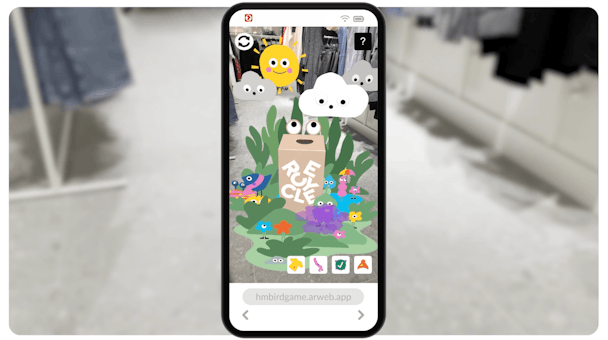Introducing the ‘endless shelf’: 5 ways AR can level up your sustainability efforts
Grace Vassallo of Zappar plugs augmented reality (AR) as a key driver in addressing environmental, social and governance (ESG) policies.

Zappar’s Grace Vasallo advises keeping greenwashing at bay by using AR to actually minimize stock waste and emissions / Zappar
Sustainability and social responsibility are key messages for consumer packaged goods (CPG) brands in the 21st century. With the crucial youth market keenly engaged with environmental, social and governance (ESG) policies around organic production, recyclable packaging and carbon footprints, the need to know exactly what brands are doing to help make the world a better place is undeniable.
Sales growth for products that claim to be ‘environmentally and socially responsible’ show that, ‘consumers care about sustainability – and back it up with their wallets’. As a result, most companies are now including sustainability as a critical component in their brand strategy.
Augmented reality (AR) is one tool that can be used to positively impact your global sustainability efforts and bridge the divide between brand purpose and consumer trust. Here’s how.
1. Tell your sustainability story from pack
The power of Connected Packaging (the ability to add digital touchpoints to passive packaging) for sustainability cannot be overstated.
72% of surveyed respondents around the world say they would be willing to pay a premium for products that claim to be sustainable, but fact-checking a brand’s sustainability claims often requires a lot of research and time that many consumers cannot afford.
With AR, brands can turn products, packaging and places into digital discovery channels, surfacing their sustainability efforts through a humble QR code.
By adding this new connection point, consumers don’t need to scour a brand’s website or wait to engage with sustainability comms delivered via social. This information can be given at the point of consideration/purchase, or at home when consumers are engaged the most – all without having to leave their smartphones.
2. Build consumer trust
As conscious consumerism starts to play a bigger role in society, brands are facing renewed impetus to build consumer trust and transparency. In 2022, it was found that nearly two-thirds of consumers today are buying or advocating for brands based on their values.
84% of young Gen Z (14-17) say that they buy on beliefs, with a five-point jump in the past year among those 18-26 years old to 64% saying they’re activists via brand choice. By nearly a 2-to-1 margin, respondents want more ‘We than Me’; they prefer to have brands make the world a better place, over brands making them a better person.
But what’s more challenging for brands, is how they communicate trust in the most effective and engaging way possible. Take our work on the H&M Kids: Global Sustainability Campaign: we introduced a third layer of spatial storytelling into their kids department.
QR activation points and posters are scattered throughout their stores launching fun and educational AR experiences for a playful way to introduce sustainability stories through ‘edutainment’, underpinning H&M’s brand purpose and commitment to sustainability and recycling.
Advertisement
3. Reduce costs and emissions with product visualization & virtual events
Brands are turning to AR to minimize in-person events and product launches, breathing new life into these activations while driving more immersion and reducing the need for travel and associated CO2 emissions, as well as costs associated with the physical production and transportation of goods and services.
Publicis.Poke created a first-of-its-kind, AR unboxing experience with UK telecom EE across all 600 of their stores, enabling customers to literally unbox EE’s new gaming offering in their homes. This connects the brand directly with the customer while avoiding the expense and associated emissions of a location-based launch event.
4. Reduce required stock with the ‘endless shelf’
Reducing costs associated with storing and transporting stock between retail outlets is another area where retailers are using AR to reduce CO2 and make savings.
AR enables digital 3D product visualization; retailers can create what we call the 'endless shelf’, where consumers can browse and engage with an infinite catalog of digital products via their device from home.
Retailers and brands can use AR to more flexibly showcase their products while bridging their online stores and physical locations to create a unified customer experience, not only benefiting the end-user but the planet, too.
5. Replace plastic premiums with digital-only
Expensive and environmentally damaging plastic premium gifts are a thing of the past with digital loyalty schemes taking the lead, offering valued customers interactive AR games, online rewards and social sharing incentives providing a great sustainable alternative to traditional loyalty schemes.
Final thoughts
Clearly, when AR is properly incorporated into connected packaging, ESG and marketing strategies it has much to offer brands, helping communicate your sustainable credentials but also facilitating efficiencies in stock management, reducing your carbon footprint as well as boosting customer engagement and brand loyalty.
With consumer trust so closely entwined with a brand’s sustainable policies, AR can help ensure transparency in customer relations, and resist the temptation to greenwash.
Content by The Drum Network member:

Zappar
Zappar is the world’s leading augmented reality platform and creative studio for mobile and web apps. Since 2011, Zappar’s mission has been to democratise AR...
Find out more
